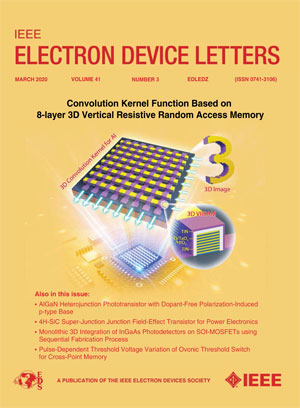利用自组装芯片级倾斜侧壁提高高功率海藻基深紫外发光二极管的性能
IF 4.1
2区 工程技术
Q2 ENGINEERING, ELECTRICAL & ELECTRONIC
引用次数: 0
摘要
众所周知,倾斜侧壁散射结构可以提高微深紫外(DUV)发光二极管的光提取效率。然而,芯片级大功率DUV led的有效倾斜侧壁设计却鲜有报道。在这项工作中,我们使用含氟的油性液体形成一个自组装的液体杯。它有一个芯片级倾斜侧壁围绕DUV LED芯片。实验和仿真结果表明,有液杯的DUV LED的发光效率显著提高。这可以归因于扩大的光锥,额外的出光面积,以及倾斜侧壁的散射效应。因此,所提出的DUV LED在350 mA时实现了10.7%的壁插效率(WPE)。与传统DUV led相比,WPE提高了64.9%。此外,光场分布表明,所提出的DUV LED更多的光向垂直方向偏转。这种方法在推进大功率DUV LED的发展和加快汞灯的替代方面显示出巨大的潜力。本文章由计算机程序翻译,如有差异,请以英文原文为准。
Enhancing the Performance for High-Power AlGaN-Based Deep Ultraviolet Light-Emitting Diodes Using Self-Assembled Chip-Scale Inclined Sidewall
It is well known that inclined sidewall scattering structures can improve the light extraction efficiency (LEE) of micro deep ultraviolet (DUV) light-emitting diodes (LEDs). However, effective inclined sidewall designs for chip-scale high-power DUV LEDs are rarely reported. In this work, we use a fluorine-based oily liquid to form a self-assembled liquid cup. It has a chip-scale inclined sidewall surrounding the DUV LED chip. Experimental and simulation results show that the LEE of DUV LED with liquid cup is significantly enhanced. It can be attributed to the enlarged light escape cone, the additional out-light areas, and the scattering effects of the inclined sidewall. Consequently, the proposed DUV LED achieves a wall-plug efficiency (WPE) of 10.7% at 350 mA. Compared to conventional DUV LEDs, the WPE is enhanced by 64.9%. Moreover, the optical field distribution shows more light from the proposed DUV LED is deflected towards the vertical direction. This method shows great potential to advance high-power DUV LED development and expedite the replacement of mercury lamps.
求助全文
通过发布文献求助,成功后即可免费获取论文全文。
去求助
来源期刊

IEEE Electron Device Letters
工程技术-工程:电子与电气
CiteScore
8.20
自引率
10.20%
发文量
551
审稿时长
1.4 months
期刊介绍:
IEEE Electron Device Letters publishes original and significant contributions relating to the theory, modeling, design, performance and reliability of electron and ion integrated circuit devices and interconnects, involving insulators, metals, organic materials, micro-plasmas, semiconductors, quantum-effect structures, vacuum devices, and emerging materials with applications in bioelectronics, biomedical electronics, computation, communications, displays, microelectromechanics, imaging, micro-actuators, nanoelectronics, optoelectronics, photovoltaics, power ICs and micro-sensors.
 求助内容:
求助内容: 应助结果提醒方式:
应助结果提醒方式:


